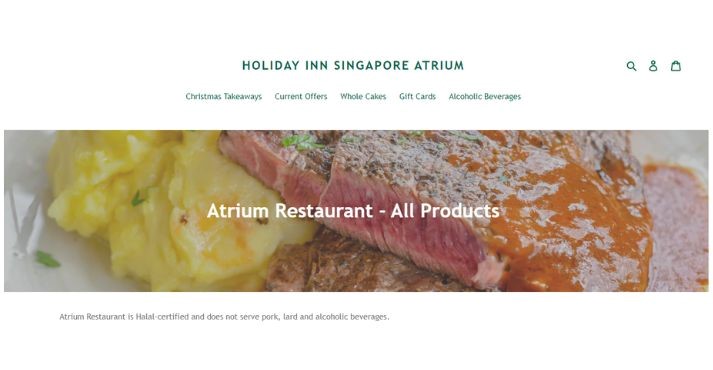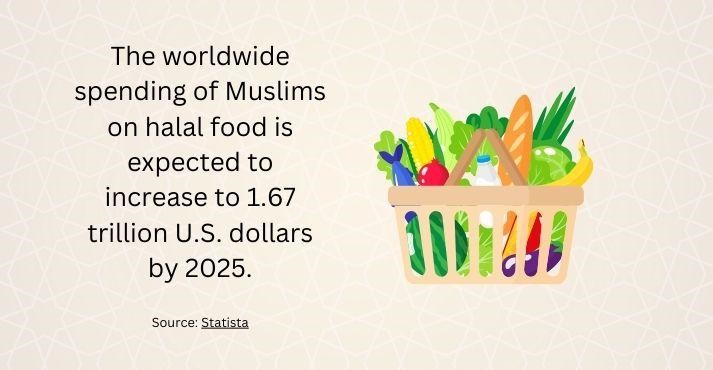Halal is an Arabic word that means allows or permits.
Muslims worldwide navigate their daily lives between halal and haram.
With a rapidly growing Muslim population, increased awareness of halal dietary requirements, and sustainable food choices, the global halal market has experienced significant transformation and growth in recent years.
The market holds immense significance due to its global reach, catering to over 1.6 billion Muslims worldwide. For Muslims, consuming Halal food is essential to their faith and adherence to Islamic practices.
Review this in-depth analysis of the halal food market in 2023 to tap into opportunities in the halal market.
- Overview: Food Halal Market
- Segmentation of the Halal Food Market
- Key Trends in the Halal Food Market
- Global Expansion of Halal Food
- Market Challenges and Opportunities
Overview: Food Halal Market

The global Muslim market has the potential to grow to about 2.8 trillion dollars by 2025, and the largest market for Muslim consumers is the halal food and beverage sector. The halal food sector accounts for 31.46 percent of the global market.
The global halal market is worth over two trillion U.S. dollars and is estimated to grow to 2.8 trillion U.S. dollars in the coming years.
The halal food and beverage market is projected to record a CAGR of 6.6% during the forecast period (2022-2027). While the Muslim population remains the key driver of the halal market, a growing number of non-Muslims are also attracted by its association with safe and healthy eating.
Segmentation of the Halal Food Market
The Halal food market is diverse and multifaceted, with various factors influencing consumer preferences. The segmentation of the Halal food market involves dividing it into categories such as product type, region, and key market players.
Product Type
Halal Foods are food products that are free from components that are prohibited for consumption by Muslims. Halal food is prepared, processed, produced, manufactured, and stored in utensils and machinery that have been cleaned according to the laws of the Islamic community.
Halal food market based on product type include:
- Meat
- Poultry
- Seafood
- Dairy Products
- Cereals and Grains
- Oil, Fats, and Waxes
- Confectionery
The meat and poultry include Halal-certified beef, chicken, lamb, ready-to-eat meals, and other products in the meat sector. To be considered Halal, the permitted animal must have been slaughtered according to the Zibah or Zabihah ritual.
The global halal meat market is estimated to reach an expected value of USD 375.05 billion by 2030, growing at a CAGR of 7.1% during the forecast period (2022–2030). Asia-Pacific is the largest consumer of halal meat.
The demand for halal cheese is rising in the dairy sector and is expected to surpass US$ 876.8 million by 2032.
According to Halal certification, food manufacturers in halal dairy are not authorized to use alcohol-based components in production and ensure that animals are neither abused nor tormented while making products.
Halal beverages are a lucrative and essential market segment, and the revenue from the non-alcoholic beverages market amounts to US$ 7.31 billion in 2023. The largest segment is soft drinks, with a market volume of US$4.68bn in 2023.
Region
The major regional markets for halal food distributors and manufacturers include:
- Asia Pacific
- Middle East & Africa
- Europe
- North America
- Latin America
According to Asia’s food and beverage statistics, Asia Pacific is projected to be the fastest-growing region in the global food market. The growth of the Asia Pacific halal food market is attributed to the presence of Halal Certification authorities in Asia Pacific that are gaining consumers’ trust.
For example, Singapore’s halal food sector has gained traction due to the country’s tourism and business location, food safety laws, and recognized halal standards.
Key Market Players
The halal food market has enjoyed significant expansion, driven by several important factors. The top halal food companies in the food market include:
- BRF SA
- CJ CheilJedang Corp.
- Daesang Corp.
- Flying Trade Group Plc
- Johnsonville LLC
- Kawan Food Berhad
- Midamar Corp.
- Nema Food Inc.
- Nestle SA
Key Trends in the Halal Food Market
The rising Muslim and non-Muslim consumer awareness regarding halal food products, investments to expand halal-certified food portfolio, and commercialization are the key to guiding the industry’s growth and future trends.
Growth of Halal-Certified Restaurants
With the ability to cater to the growing demand of the international halal market, there has been a surge in the number of halal-certified restaurants, delivering diverse culinary preferences.
These establishments offer traditional halal cuisines and fuse them with global flavors, appealing to a broader audience seeking high-quality, diverse halal dining experiences.
Increased Demand for Convenience Halal Products
Like any other industry, convenience has become the key to the halal food market, as consumers demand ready-to-eat and easy-to-prepare halal products.
From frozen meals to snacks, consumers seek time-saving halal products that align with their dietary requirements, taste, and quality.
Plant-Based and Vegan Halal Products
As health-conscious consumers seek ethical and sustainable options, plant-based and vegan halal products are increasingly in demand. This category caters to Muslims and a growing segment of health-conscious and environmentally aware consumers.
Technology-Enhanced Traceability
Blockchain, QR codes, and mobile apps are being used to provide consumers with real-time information about the sourcing, processing, and halal certification of products, instilling greater confidence in the authenticity of halal offerings.
For example, Holiday Inn Atrium is a Halal-certified restaurant that does not serve pork, lard, or alcoholic beverages. Also, they have mentioned on their website that customers can quickly check and verify their halal certification.

Source: Holiday Inn Singapore Atrium
Global Expansion of Halal Food
Since the beginning, halal food has been associated with Muslims. But now it’s gaining popularity among non-Muslims.
The increasing number of consumers seeking healthier and ethically produced food options drives demand for halal products and creates pressure on food importers to make halal options more accessible.
For non-Muslims, halal food products are fast becoming synonymous with food safety, hygiene, and health.

The worldwide spending of Muslims on halal food is expected to increase to 1.67 trillion U.S. dollars by 2025. Asia is at the forefront of Halal products, Brazil is the world’s largest Halal Food exporter, and the Brazilian halal food market is expected to reach around $5.74 trillion by 2024.
As the Halal food industry expands, certifications and labeling make it easier for consumers to identify and trust the halal product.
Also, the growth of international travel and the restaurant industry has further promoted halal cuisine, appealing to a broader audience, regardless of their cultural or religious background.
Moreover, the pandemic opened up new opportunities in halal food e-commerce and delivery business sectors and new food product categories.
Market Challenges and Opportunities
Owing to the growth potential, halal food is no longer viewed as an exclusive niche market but a new business paradigm in the Food and Beverage market.
The halal food market faces specific challenges, primarily the ongoing confusion surrounding the certification standards as they are manufactured in different countries and regions.
The challenge for manufacturers is determining which standard will provide market access and evaluating whether certificates are necessary for exporters.
Moreover, another significant challenge relates to the supply chain and distribution network. Given the intricacy of the halal food supply chain, the integrity of the entire supply chain is of utmost importance.
Also, the handling of halal products requires separate transportation and storage facilities.
According to the report, The Future of World Religions: Population Growth Projections, 2010-2050, published by the Pew Research Center, the global Muslim population is expected to grow twice as fast as the rest of the world’s population by 2050, primarily due to high fertility rates and a youthful population.
Some of the key opportunities include:
- It is tapping into a vast, diverse consumer base seeking halal-certified products.
- The rise of the ethical consumer has attracted even non-Muslim consumers to halal food products.
- Businesses can develop unique halal-certified products, such as plant-based alternatives or specialty foods, to cater to changing consumer preferences and dietary needs.
- E-commerce platforms allow for efficient distribution, marketing, and accessibility, making it easier to serve halal-conscious consumers globally.
Halal Food Market (FAQs)
What are the key factors driving the global halal food market?
The key factors driving the global halal food market:
- Growing Muslim population
- Increasing halal certification
- Awareness of halal dietary guidelines
- Demand for convenient and ready-to-eat halal options
- Enhanced international trade
- Growth of e-commerce platforms to facilitate accessibility
- Boosting consumer confidence and market growth
What is the target market of halal food?
The target market for halal food is primarily the Muslim population, but it extends beyond and includes:
- Muslim consumers
- Non-Muslim consumers
- Health-conscious consumers
- Tourists and travelers
- Special dietary needs
- Globally aware and culturally diverse consumers
What is the future of the Halal food industry?
The market revenue of global halal food is forecasted to increase to 2.04 trillion dollars by 2027. The global halal market value is estimated to grow to 2.8 trillion U.S. dollars in the coming years.
Closing Thoughts
The global halal food market is witnessing remarkable growth, reflecting the increasing demand for the halal food and beverage sector.
With a broader consumer base seeking quality, transparency, and ethical food practices, the industry is progressing on a growth trajectory.
New business opportunities are opening, driven by a convergence of religious adherence and global consumer preferences in the international halal market.
Therefore, a positive outlook can be pictured for the halal food market, as the industry continues to appeal to the non-Muslim population and bears opportunities outside of Muslim-majority countries.













